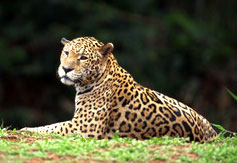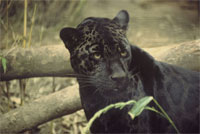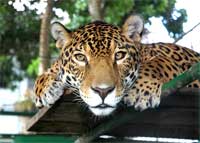|

 Sturdy cats with rosettes: To some, jaguars look very much like leopards, but they are sturdier and heavier. The easiest way to distinguish a jaguar from a leopard, beside the jaguar’s much more powerful build, is by the rosettes. The rosettes on a jaguar’s coat are larger, fewer in number, and usually darker with thicker lines that enclose smaller spots. The head of the jaguar is more round and it has shorter, stockier limbs. Because of this the jaguar is sometimes referred to as the “bulldog” of the cat world. Sturdy cats with rosettes: To some, jaguars look very much like leopards, but they are sturdier and heavier. The easiest way to distinguish a jaguar from a leopard, beside the jaguar’s much more powerful build, is by the rosettes. The rosettes on a jaguar’s coat are larger, fewer in number, and usually darker with thicker lines that enclose smaller spots. The head of the jaguar is more round and it has shorter, stockier limbs. Because of this the jaguar is sometimes referred to as the “bulldog” of the cat world.
 Black panthers: A condition known as melanism regularly occurs, creating jaguars that appear entirely black (although the spots are still visible if one looks closely). Relatively frequent melanism is due to the fact that a dominant rather than recessive allele causes the colouration. Melanistic jaguars are informally known as black panthers, but do not form a separate species. Black panthers: A condition known as melanism regularly occurs, creating jaguars that appear entirely black (although the spots are still visible if one looks closely). Relatively frequent melanism is due to the fact that a dominant rather than recessive allele causes the colouration. Melanistic jaguars are informally known as black panthers, but do not form a separate species.
Size: Jaguars vary from 5.3 to 6 feet (1.62 to 1.83 m) in length, including a 30 in (0.76 m) tail, stand around 67 to 76 cm (27 to 30 inches) tall at the shoulder, and weigh between 56 and 96 kg (124 and 211 lb) with larger individuals, recorded by scientists, weighing between 131 and 151 kg (288 to 333 lb). Females are typically twenty percent smaller than males. Jaguars in southern Mexico and Central America are typically smaller, 56 kg and 40 kg (123 lb and 90 lb) for males and females respectively.
Power-cats: Jaguars are powerful animals for their size. The jaguar, in a recent National Geographic special titled In Search of the Jaguar, was named pound for pound the most powerful cat in the world. Throughout the evolutionary history of mammals, the size and power of predators have been proportional to those of their prey. A predator needs to be strong and fast enough to catch its prey. Jaguars hunt wild animals in the range of 300 kg and below in dense jungle; their short and sturdy physique is thus an adaptation to hunt those preys in that environment.

No mountains: The jaguar's habitat ranges from the rain forests of South and Central America to marshy and even desert terrain in Mexico, but they are rarely seen in mountainous regions. The jaguar's wide range means that it should not be in danger of extinction in the foreseeable future. The species has declined numbers in some areas due to habitat loss, especially in rain forests and grassland turned into cropland and hunting for their pelts.
 Swimmers: Known for their strong swimming abilities, the jaguar is one of the few cats besides tigers that enjoy water. They often prefer to live by rivers, swamps, and in dense forest with thick cover for stalking prey. Swimmers: Known for their strong swimming abilities, the jaguar is one of the few cats besides tigers that enjoy water. They often prefer to live by rivers, swamps, and in dense forest with thick cover for stalking prey.
Jaguars USA? Jaguars, on rare occasions, are seen as far north as the southwestern United States, particularly in Arizona, New Mexico and Texas. In the early 1900s, the jaguars' range actually extended as far north as Southern California and western Texas. As recently as 2004, wildlife officials in Arizona have photographed and documented jaguars in the southern parts of the state. Presently it is unclear whether recent sightings indicate whether there is a permanent population developing in the Southwest or that these cats are simply transients straying over the border from Sonora, Mexico.
 Protected in USA: However, jaguars are a protected species in the United States under the Endangered Species Act and are considered nongame, therefore making it illegal to shoot a jaguar for its pelt. Fossils of jaguars from as far north as Missouri confirm these cats inhabited much of the Southern United States during prehistoric times. These prehistoric jaguars were significantly larger than the jaguars of today. Protected in USA: However, jaguars are a protected species in the United States under the Endangered Species Act and are considered nongame, therefore making it illegal to shoot a jaguar for its pelt. Fossils of jaguars from as far north as Missouri confirm these cats inhabited much of the Southern United States during prehistoric times. These prehistoric jaguars were significantly larger than the jaguars of today.
The ecological role of the jaguar most closely resembles the tiger. They are considered an umbrella species. An umbrella species is defined as a species that generally cover large areas in their daily or seasonal movements. They serve as "mobile links" at the landscape scale, through predation, seed dispersal or pollination. Protecting enough habitat and connectivity to assure viable population of these organisms benefits many other species more restricted in their range. The jaguar is an apex predator. They can run at amazingly high speeds, using its speed to catch its prey.
Solo hunters: Jaguars are hunters that do not work with one another outside the breeding season. They hunt around 85 different species including: deer, tapirs, peccaries, and even caiman, up to a certain size. They are opportunists and will take anything from frogs, mice, birds, fish, to domestic livestock. A jaguar's bite can pierce the shell of a turtle. Jaguars are considered a stalk and ambush predator and are not meant to run over long distances but prefer to surprise unsuspecting prey.
Brain piercing: The jaguar uses a different killing method from most cats to kill its prey. Instead of biting the neck, to suffocate or sever the spinal cord, the jaguar delivers a fatal bite directly to the skull, piercing the brain. It is because of this killing technique that jaguars often break teeth as they progress in age. Jaguars eat up to 10-70 pounds (5-32 kg) of food daily.

Young jaguar males reach sexual maturity at about three to four years of age, with females reaching maturity about a year earlier than males. Females give birth to as  many as four cubs after a 90 to 110 day gestation, but raise no more than two of them to adulthood. The young are born blind and can see after two weeks. They remain with their mother for up to two years before leaving to establish a territory for themselves, which can be anywhere between 25 and 150 square kilometers in size (depending on the availability of suitable prey). Typical lifespan is 10 or 11 years in the wild; in captivity, jaguars have lived up to 20 years. many as four cubs after a 90 to 110 day gestation, but raise no more than two of them to adulthood. The young are born blind and can see after two weeks. They remain with their mother for up to two years before leaving to establish a territory for themselves, which can be anywhere between 25 and 150 square kilometers in size (depending on the availability of suitable prey). Typical lifespan is 10 or 11 years in the wild; in captivity, jaguars have lived up to 20 years.
All text is available under the terms
of the GNU Free Documentation License
|
